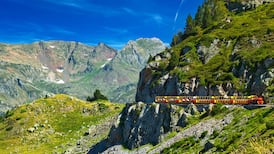Peig had to face many challenges crossing to and from the Great Blasket, but I'm fairly certain this wasn't one of them. I'm standing on a wall, with my hands gripping the roof of a car. Below is a steep drop to the pier at Dunquin. I edge my way along the wall to pass the car, which is blocking the narrow zigzag path. The choice on the other side was an even steeper drop into the Atlantic, choppy now and grey skied.
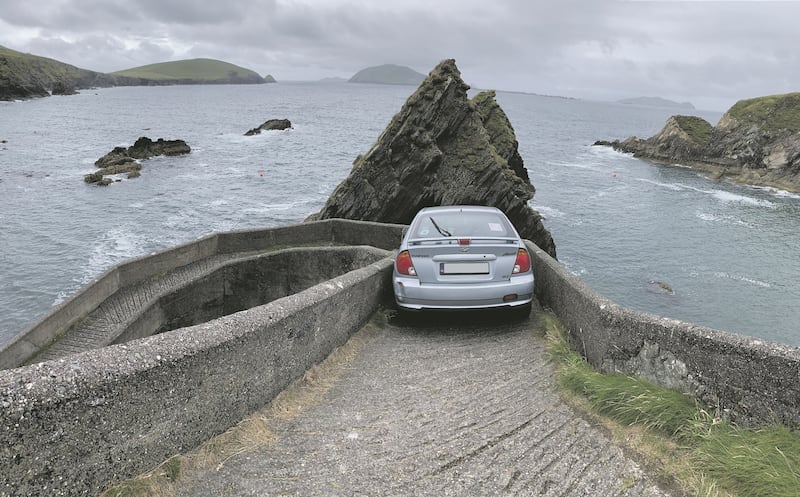
No ferries are making the crossing today, but Billy, who runs the only accommodation on the island, is here to pick me up. His rib is called the Peig Sayers, after the island storyteller who dictated her autobiography to her son, and whose words still haunt hundreds of thousands of former Leaving Cert students across Ireland. Few will forget the first line that begins " Seanbhean is ea mise anois." "I'm an old woman now with one foot in the grave and the other on its edge."
0 of 5
But Peig also spoke of the Blasket’s beauty, and I’ve been longing to return to the island I first stayed on more than 25 years ago. That time I crossed in a naomhóg, a tarred canvas currach, and got stuck for four days because of the swell. There was no Wild Atlantic Way back then. Wildness came unpackaged, and I wanted to know if that sense of freedom could still be found.
As we ride the waves across the Blasket Sound the two guys who helped me over the car tell me they’re heading “into the island” for two nights. Old school pals Mark and David are on their fifth odyssey to an Irish island. The Blaskets, now abandoned, have been drawing tourists since the beginning of the 20th century, with scholars and writers encouraging the islanders to write down their stories and creating an island library of published works that is unique in Europe.
There is a freshness and brightness in everything God created. The sea is polished and the boys are swimming down at the shore
Billy moors off the island and we transfer to a dinghy for the trip to shore, entering the tiny harbour. From here it’s a steep climb through the ruined village, once home to more than 160 people. We pass the ruins of Peig’s first home on the island, and reach the house she moved into in 1910, one of five cottages built into the hill above a white sand beach. There’s one big room with a fireplace where she did her cooking, another room off it, and two bedrooms upstairs under the eaves. Like in Peig’s time, my bathroom is outside, and there is no electricity.
I open my half door, which frames the view that would have greeted her for most of her life. Mount Eagle on the mainland is shrouded in mist, but here the Trá Bhán is lapped by a turquoise sea. Wheatears flash their white rumps as they rise from a ditch. It’s turning into the kind of day Peig spoke of in one of her more uplifting paragraphs, “There is a freshness and brightness in everything God created. The sea is polished and the boys are swimming down at the shore.”
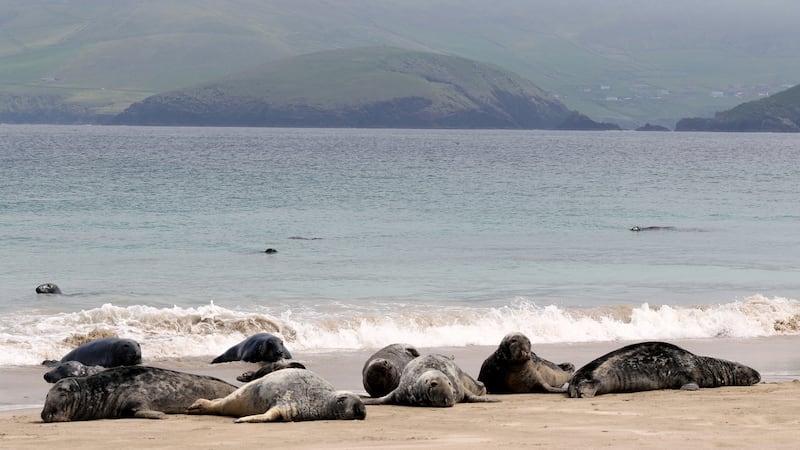
Today the only sounds from the beach are the reassuringly repetitive waves reaching the strand and the groans and cries of the hundreds of grey seals lining the water’s edge. Hunted in Peig’s day, they are now protected.
With no ferries running, there are only six of us on the island, including Gordon and Lesley who look after the accommodation and run the tiny cafe. They answered a call on social media to live on the island for the season, and have stayed here in all weathers, including Storm Hannah, when they stood outside to feel its force.
“We were the only people here. It was my favourite time, so peaceful,” says Lesley. “We weren’t waiting for the electricity to go or a tree to come down, because there aren’t any.”
No electricity soon means no phone, and soon time has no meaning any more.
Next morning I pass a slate sign marked “spaisteoireachte” – to ramble, or stroll aimlessly. Climbing above the house I walk the loop path leaving the sea and the mainland on my right. Rounding the bend the Fear Marbh – Inistuaisceart – and the pyramid of Tearacht come into view. Meadow brown butterflies lead the way along the grassy path and skylarks trill and dip over the heather. Clover, sheep’s-bit scabious and dozens of other wildflowers are in bloom, more than I can remember on my previous visit, probably because there seem to be fewer sheep.
Last time I was here I was running barefoot by the end, and I take off my shoes to feel the earth under my feet. A red admiral brushes against my fingers and is gone.
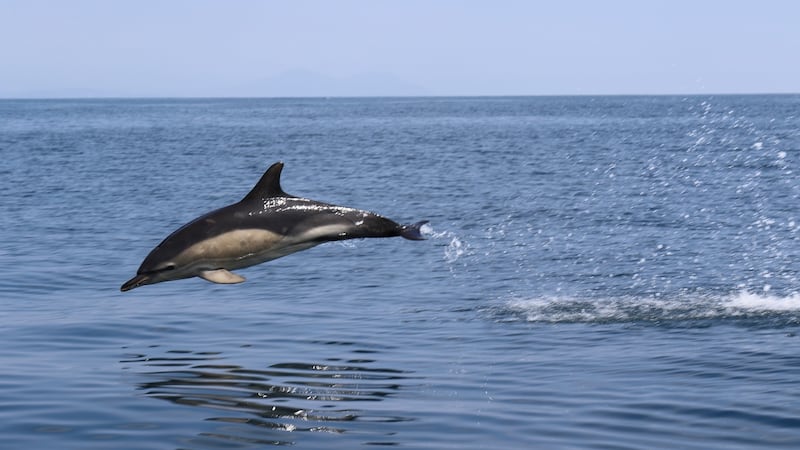
After the “traffic lights”, the name given by islanders to the junction on the main path, I head right towards the Dún, a promontory fort from the Iron Age, and the earliest evidence of human habitation on the island. Far away to the left, the Skelligs are floating on a silver sea. From the top of an Dún, I can see Inishvickillaune, the holiday island of the Haughey family. Unless they are visiting, I am now the most westerly person in Europe.
Which is exhilarating, but also demands a degree of caution. Beyond Inishvickillaune a dark navy band of rain is advancing rapidly across the sea and within minutes the entire island disappears. I pull on my rain gear and retreat from my eyerie back to the “traffic lights”. But as is often the way on the island, only the edge of the rain reaches me, and the sun is soon blazing again as I turn for home.
Home. Within less than 24 hours a degree of familiarity, even possession, has emerged. I round a corner and suddenly the village is below me, and I can imagine the relief of the islanders as they returned with turf or birds’ eggs from the cliffs, and saw the fires burning in the now-ruined cottages below.
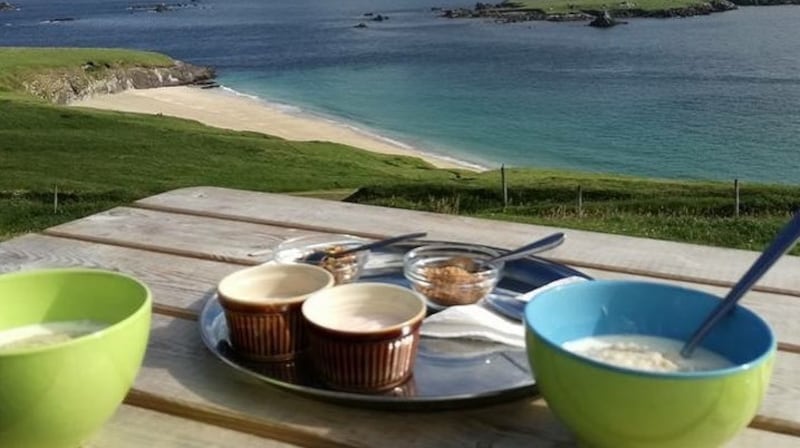
The Peig Sayers is just offshore, and I join Billy and other visitors to explore the back of the island and the rest of the archipelago. We sail below the path I just walked, and from this angle it is clear that the island is a continuation of the mainland mountain range with two distinct peaks, an Dún and an Cró.
At the end of the island we enter the sound between the Great Blasket and Inis na Bró. Waves crash over the rib as we meet the full force of the Atlantic, channelling the tide through the narrow cut. Billy is gunning for the Cathedral Rocks, a dramatic pinnacled Gothic formation.
We also get our best view yet of Tearacht, the island home of the most westerly lighthouse in Europe. Gannets dive headfirst into the water folding their wings at the last moment and dozens of puffins skitter across the sea, their cartoon-like attempts at take off and landing giving everyone the giggles. Soberingly, Billy says the numbers this year are way down on previous breeding seasons.
“Look!” An American woman has spotted a dolphin on our port side and Billy slows down. “There!” The dolphin leaps right beside the boat. It’s a common dolphin, and now there are two, leaping in front of our bow wave. We turn again and there they are, but this time there’s a baby dolphin in between. We’re smitten by this joyous display, a sighting of nature in the raw, that can’t be guaranteed but is wonderful when it happens.
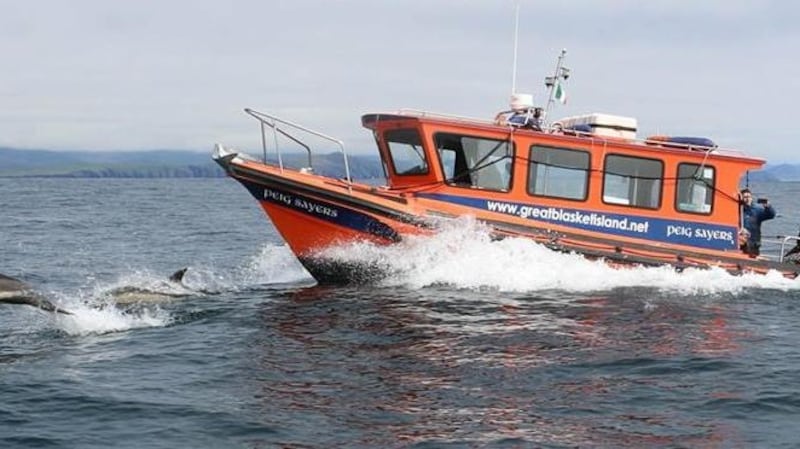
Dolphins are a common sight from the boat, as are minke whales and, more rarely, humpbacks and other species.
By the time we reach the island again I am glad to be home, to light the stove after a day in the fresh air. Mark and David, the two men on their island odyssey, share dinner at the dining table in Peig’s cottage. As the last shard of light disappears into the western sky, another visitor joins our company, as hundreds of people did during her lifetime.
For every night Peig would tell stories by this fireplace, of death and fairies and weather and lives lost and found. And we too tell stories by candlelight, of lives lived in far away places, of dolphins observed and food supplies secured, and what wind guru is saying about the weather tomorrow.
But our tales are in English not Irish, and the folklore, passed down from generation to generation, is missing too. The stories that passed the time on bleak winter nights also passed on a rich knowledge of people, place and myth, rendering the harshness of island life into stark yet elegant prose.
“They didn’t leave any artefacts behind. They took everything with them,” says Lesley. “Their heritage is bound up in in folklore, in stories and songs, things you can’t touch. That type of heritage is so much at risk from globalisation and social media.”
When Tomás Ó’Criomhain wrote An tOileánach, its reception in the late 1920s showed the islanders that their lives and their stories were worth writing, worth reading and worth preserving. They wrote as if they knew, and at some level they did, that the life they lived there was ending, and that in O’Criomthain’s words, “ni bheidh ar leithéidí arís ann”.
We are in the eye of the storm. The power can't go out, because there is none
In the early part of the night I wake to screeching, the likes of which I had never heard before. I later learn that it was the sound of hundreds of Manx shearwaters returning to their burrows. The seals are gone from the shore and their crying does not lull me to sleep; they must have known what was coming. A few hours later, the loudest thunder I have ever heard rips through the sky above the cottage, and lightning pierces the blackness, illuminating the Blasket Sound. There are only a couple of seconds between the two.
We are in the eye of the storm. The power can’t go out, because there is none.
I’d love to know if Peig would like Billy’s plan to install solar power on her cottage roof, but for now the island is one of the wildest parts of the Wild Atlantic Way. Listening to the rain battering the windows, that’s how I hope it remains.
Margaret Ward was a guest of Fáilte Ireland. wildatlanticway.com
How to . . .
Self-catering accommodation and eco-tours www.greatblasketisland.net
Ferries www.blasketisland.com
The Blasket Centre in Dunquin, a Discovery Point on the Wild Atlantic Way, is well worth visiting before your trip blasket.ie. OPW tours of the village are free and run at 12 noon, 1pm and 2pm on the days the ferries run from Dunquin.
Bring insect repellent, head torch, sunhat, rainjacket, waterproof trousers, walking shoes and enough food. Breakfast can be provided.








